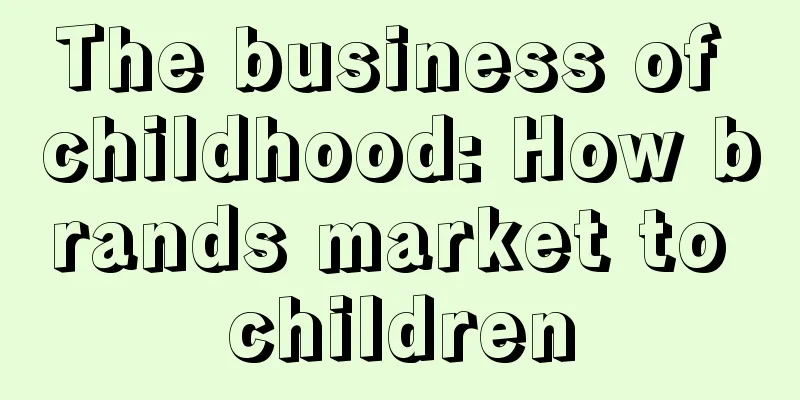The business of childhood: How brands market to children

Children's Day is coming soon. In the past few decades, the children's market has always been the focus of brands and businesses. This special market segment not only has huge consumption potential, but also affects the core driving force of family purchasing decisions. According to a data, children in the UK and the US bring in about 700 billion pounds in sales each year, which reveals the huge value of the children's market. Data from the Economic Daily in 2021 pointed out that in terms of children's clothing, food and beverages, sports equipment and various extracurricular activities, the scale of China's children's goods and services market has expanded to 4.5 trillion yuan. According to QuestMobile data, as of April 2022, the proportion of users with monthly online spending power exceeding 1,000 yuan in families with children reached 69.9%, an increase of 5.9 percentage points from five years ago. This data shows that the potential of children and their families in online consumption is growing rapidly. Obviously, the children's consumer market is a market that businesses and brands attach great importance to. So in the face of such a huge and valuable market, how do brands and businesses conduct marketing to children? How do their strategies and actions unconsciously affect children's current and future consumption behaviors? In this article, I will explore the marketing strategies of brands and businesses in the children's market. 1. Children have a sense of brands from an early ageChildren's perception of brands begins at a very young age. For example, if one or two-year-olds watch Baby Go Go or Peppa Pig, they will soon have a deep memory of these characters and even keep thinking about them. This early exposure leaves a preliminary impression of the brand in the minds of children and lays the foundation for future brand loyalty. Research shows that children can already recognize the logos of specific brands at the age of 3 and express preferences for specific brands at the age of 5. For example, when making food choices, children tend to choose brands that they are familiar with. By the age of 10, children can identify up to 400 brands, indicating that they have a broad and in-depth understanding of the brands on the market. This early brand awareness has a significant impact on their long-term consumption behavior and brand loyalty. One statistic is that about 80% of people have determined their preferred soft drink brand before the age of 18. Of these 80%, only 20% will change their preferences after adulthood, and of these 20%, half will return to their "first love" brand. So, assuming a child develops a preference for the Coca-Cola brand during childhood, he or she will hardly switch from Coca-Cola to Pepsi when he or she grows up. This shows that brand marketing investments made on children and teenagers are more effective than those made on adults. For children, the "emotional agreement" between them and a brand has already begun before the consumption behavior actually occurs. Take cars, for example. Children already discuss their favorite car brands before they even get their driver's license. This early brand attachment typically doesn’t fade with age, and the same thing happens with other categories like jeans, sneakers, and soda. This means that if a brand fails to gain a foothold at this stage, competitors are likely to swoop in. At that point, it will be costly to defeat the competition. 2. Television advertising: the marketing with the greatest impact on childrenIn the era without smartphones, there was almost no child who was not influenced by television. The way brands marketed to children was to put advertisements before, during, and after the cartoons were broadcast. These advertisements left a deep impression on children. I still remember some of the advertisements from my childhood, such as "Mom, I want to drink Wahaha fruit milk" and "We love to eat Xizhilang, yayayayo". According to the film "The Root Causes of Uncontrolled Consumption", in the UK, the pace of television advertising marketing targeting children accelerated in the 1970s, and brands increasingly produced advertisements targeting children. However, advertisements that did not look like advertisements had a greater impact than direct advertisements to children. Hasbro and Mattel, two of the world's largest toy manufacturers, are the creators of Transformers and Barbie, respectively. They were also the first to use television as a new way to sell toys, with a strategy of creating toys first and then creating stories around them. Transformers is the first and most successful example of using this strategy. According to Hasbro's strategy, advertising company Griffin Bacall developed a story universe for Transformers. By giving characters to toys, the brand was able to write TV shows around these characters, for example, the Transformers story has Optimus Prime and Decepticons, this classic storyline of good and evil is popular with boys. Transformers marketing included TV series, comic books and toys. From bedding to Halloween costumes, lunch boxes and water bottles, Transformers were everywhere. In just two years, toy sales reached $300 million. The Transformers cartoons are essentially advertisements disguised as programs, with each episode carrying a half-hour-long strong sales pitch to young children. This practice of blurring the line between advertisements and programs has achieved great commercial success, but it has also sparked discussions on the ethics of marketing to children. 3. Character/IP Marketing: Turning Characters into CommoditiesChildren start to develop connections with specific characters from a very early age, and initially, this connection may be simply “I like this character”, but as they grow, this connection gradually develops into “I want to be this character”. When a character becomes popular with children, it not only appears on products such as bedding and biscuits, it may even push up the prices of these products. Star Wars created a multimedia story universe. This series of movies is closely integrated with the toy industry, opening up a new era of children's marketing and creating a huge brand influence. George Lucas created character toys for the entire Star Wars universe, and almost every character in the film became a toy. The character designs and storylines in the movies create a deep emotional connection with children, which makes them more willing to collect toys and products related to these characters. Star Wars has been extremely successful in licensing its characters. George Lucas has innovatively adopted the toy franchise strategy, and a large number of products such as bedding, biscuits, and tableware have adopted Star Wars characters and logos. This wide brand coverage has increased its visibility in the children's market. Since the release of the first film, Star Wars has sold £13 billion worth of branded products worldwide. Another amazing thing about "Star Wars" is that it not only created a new children's market, but also made countless adults "become children" and pay for the IP. Another company that has adopted the same strategy is Disney. From movies, theme parks to licensed merchandise, Disney has created a cultural empire with the help of movie characters. 4. Children’s Experiential MarketingIn the past, I never quite understood why McDonald's, a restaurant, and IKEA, a home furnishing store, both have children's play facilities. Later, I found out that these brands have good intentions. They want to implant brand memories into children's brains from an early age. As a "parent-child happy restaurant", McDonald's has created an environment for parent-child interaction in its experiential marketing for children and launched a series of activities specifically for children to enhance children's favorability towards the McDonald's brand. First, McDonald's has set up children's play facilities in its restaurants as part of its experiential marketing. These facilities allow children to naturally connect with the McDonald's brand while having fun. In this way, McDonald's has successfully implanted positive brand memories in children's minds. In addition, McDonald's also organizes various children's activities to further deepen this connection. For example, McDonald's "McMc Experience Camp" is a typical case. In this activity, children experience jobs such as making burgers, cashiering and cleaning under the guidance of employees. This experience not only allows children to understand McDonald's brand culture and values, but also teaches them some life skills and professional qualities. Through this participatory activity, children not only learn new skills, but also invisibly enhance their favorability and loyalty to the brand. In addition, McDonald's "Happy Meal" is also an important part of experiential marketing for children. This meal designed specifically for children includes hamburgers, French fries, drinks and toys. By offering toys in collaboration with classic IPs such as Transformers, Disney and Marvel, McDonald's not only satisfies children's desire to collect and exchange, but also strengthens the emotional connection between children and the brand. Through children's play facilities, participatory activities and special meals, McDonald's has successfully built a positive brand image in the minds of children. This marketing strategy, which starts from an early age, is crucial to establishing and maintaining the long-term success of the brand. 5. Social Marketing, Peer Buying PressurePsychological research shows that for children, the influence of playmates is often greater than that of parents. The carrot knife that became popular among primary school students some time ago is an example. If a student's classmates all have a carrot knife and he does not have one, he will face pressure and social pressure to buy one. As a very popular product among students, Xiaotiancai Watch cleverly uses children's social characteristics for marketing. It enables children to communicate and interact with their peers in an interesting and convenient way through functions such as "touch to add friends", micro-chat and friend circle. These features not only enhance social connections among children, but also encourage them to form and join their own social circles, thereby increasing product stickiness and dissemination effects. In this context, children without watches may experience social pressure because they find it difficult to fit into the social circles formed by watch users. Another example is the trendy shoe market, especially the popular trend among middle school students. Since middle school students usually need to wear school uniforms on campus, they have limited space to express their individuality and uniqueness. In this context, trendy shoes have become an important way for them to express their individuality. As a result, the student group is naturally divided into two camps: those who wear trendy shoes and those who wear ordinary shoes. Xiaotiancai watches strengthen the connection between children through social functions, while trendy shoes have become a symbol of personality expression and social identity for young people. These strategies have increased the market appeal of the brand and deepened the impression of the product in the minds of children and teenagers. 6. Let children promote their parents’ consumptionWhile brands are influencing children, they are also using their influence to promote family consumption. As media and advertising penetrate into people’s lives, children’s influence on their parents’ consumption decisions is not limited to toys or snacks, but has also expanded to larger family purchasing decisions. For example, when buying a family car, the children’s voices are also widely heard. Take the example of Japanese automaker Toyota, which, faced with the challenge of declining van sales in the late 1990s, chose an innovative strategy: if they couldn’t sell vans to parents, why not try selling them to kids? Toyota engineers came up with a new kid-friendly design, such as comfortable seats and a widescreen rear-seat entertainment system, inspired by children's input and preferences. This shift in design philosophy, which puts children's preferences and needs at the center of product design, has effectively attracted the attention of family buyers. Today, Ideal Manufacturing also uses this marketing approach, promoting family consumption decisions by installing child-friendly facilities such as "sofas", "TVs" and "game consoles" in cars. By focusing on the needs and preferences of children, brands can indirectly influence parents’ purchasing decisions and drive family-level product sales. This approach not only increases the appeal of the product, but also strengthens the connection between the brand and the consumer’s family. VII. ConclusionWith the diversification of consumer behavior and the intensification of market competition, children have become a key target group. Through precise marketing strategies targeting children, brands can not only directly attract young consumers, but also indirectly influence the purchasing decisions of families. By forming an impression by placing advertisements in children's favorite programs, promoting sales by turning children's favorite characters into commodities, building brand favorability among children through entertainment experiences tailored to children, and pushing children to buy products through social pressure, brands not only gain advantages in the children's market but also indirectly influence the adult market through children. Author: Xunkong Source public account: Xunkong’s Marketing Revelation (ID: 846631) |
>>: Taobao returns to users, and users return to Taobao
Recommend
What are the methods and techniques for selecting products on Amazon? What should you pay attention to?
On Amazon, people usually open a store. When openi...
Mixue Ice City Globalization: The Snow King Sings and Dances His Way Around the World
Many brands have their own brand spokespersons or ...
Is cross-border e-commerce possible? How does it work?
Speaking of cross-border e-commerce, in fact, many...
Will monthly rent start to be charged after successfully registering an Amazon account? Frequently Asked Questions about Monthly Rent
More and more merchants are opening stores on Amaz...
Are new Amazon sellers reliable? What should you pay attention to when buying an Amazon store?
For novice sellers, they often worry about whether...
How to bind Orange Logistics to eBay? How to calculate Orange Logistics fee?
As a professional cross-border logistics service p...
What does the Amazon order status "pending" mean? Has the buyer paid?
In order to improve the user experience of the pla...
How to write an Amazon Spring Festival holiday notice? What templates are there?
Before the Spring Festival holiday, Amazon merchan...
Is it still possible to increase the volume of Xiaohongshu?
As a content-driven social platform, Xiaohongshu i...
Soy sauce latte, that’s it?
Jiangxiang Latte is a hit! The topic has even spre...
Museums "come down to earth" to make money, and tourism "special forces" can't handle it anymore
For museums, becoming internet celebrities is a tr...
How does Shopee find the source of goods for cross-border e-commerce? How to run Shopee well?
Shopee, like AliExpress, is a cross-border e-comme...
Is printer sharing a profitable business?
With the development of the sharing economy, why a...
What is the reason for Lazada's full-effect treasure being suspended? Full-effect treasure operation guide
When running a store on Lazada, you can also use s...
Who is the owner of the vova cross-border e-commerce platform? How is this platform?
In the field of cross-border e-commerce, vova, as ...









